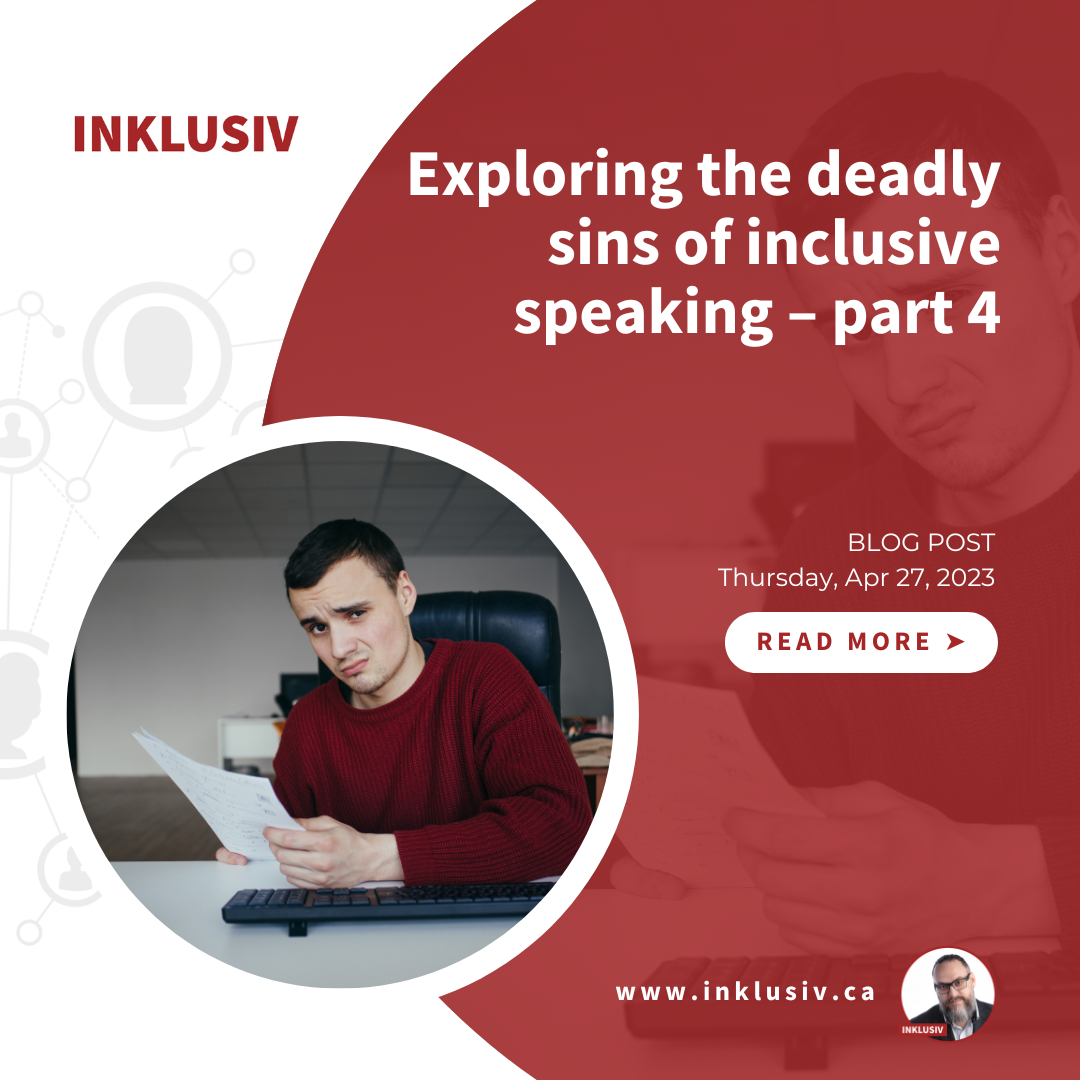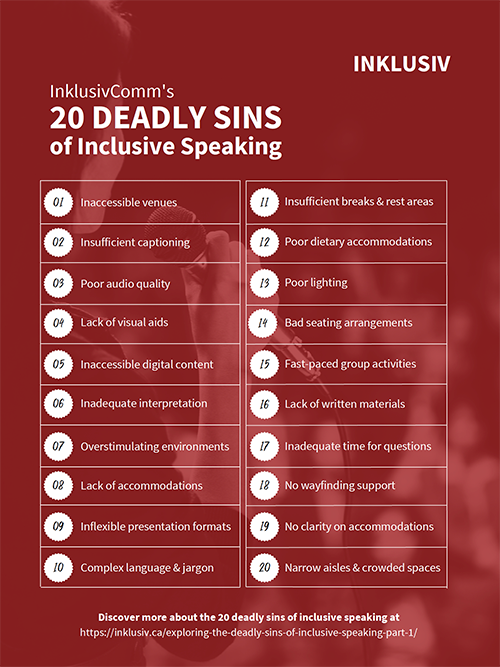Exploring the deadly sins of inclusive speaking – part 4

Okay… it’s been a fun ride these past few weeks working through this series, but we’re now at a point where it’s time to wrap things up on our “20 deadly sins of inclusive speaking”. Today, I want to go over the remaining five common challenges faced by audience members who have disabilities, as they venture into live, in-person or virtual events. So far, we’ve seen quite the list of challenges that impact both speaking professionals and event planners alike. Trust me, this week’s list will be no exception!
From a lack of written materials to properly support audience members in a way that works for them to planning for an inadequate time to answer questions, from failing to provide sufficient or appropriate wayfinding support to gaps in clear communication on accommodations made available, or simply failing to plan for a proper set up in spaces to allow everyone to freely move around, there are still quite a few things we can add to our list this week!
Also, be sure to check out our “20 deadly sins of inclusive speaking” poster provided at the end of the post today, which summarizes all 20 deadly sins in one convenient – and accessible – pdf handout for you to download and hopefully share with everyone you know who plays a role in live, in-person or virtual events.
So, without further ado, and as we’ve been doing these past couple of weeks, let’s start with a bit of a story, contextualizing this week’s list of examples of challenging situations faced by audience members who have disabilities, inspired by our group of inclusive speaking personas. This week, the story highlights the misfortunes of Uma, Vivian, and Lizzy. Let’s go.
Yet even more ways in which we fail our audience
Uma, Vivian and Lizzy, briskly making their way into the bustling Conference Centre, were ready to attend this highly-anticipated web design conference. The first day’s agenda featured this exciting three-hour pre-conference workshop with a rockstar designer that everyone was raving about. Hoping to gain valuable insights into their fields and eager for opportunities to network, the three friends were excited to immerse fully in the conference’s experience. But fate had other plans in store for them, and throughout the day, they would run into several obstacles that would greatly impact their ability to participate in the activities, enjoy their learning, and make those much-anticipated meaningful connections.
It really only took a few minutes for Uma, who is completely deaf, to run into her first disappointment. She quickly discover that no printed or written materials had been planned by the speakers to support the presentations. How disheartening! Without such supporting materials, Uma quickly found herself struggling to understand what the speakers were saying, which, in turn, only made grasping the key concepts discussed that much more difficult. The absence of written resources put her at a significant disadvantage, hindering her ability to engage with the workshop and the other attendees. What a disappointment!
Meanwhile, Vivian, well into her late 60s, was facing struggles of her own, triggered by age-related vision and auditory challenges. For starters, the Conference Centre’s questionable lighting choices would make it difficult for her to efficiently read the visual aids or presentation slides. And then, the limited amount of time allocated for questions during the workshop was leaving her feeling both rushed and unable to process the information at a pace that was comfortable to her… And then, with her hearing also not as sharp as it once was, Vivian quickly found herself struggling to participate in group discussions, which left her feeling just as isolated and disheartened as Uma did. Total bummer.
And then Lizzy’s vestibular disorder, which caused her to deal with severe, constant feelings of dizziness, made navigating the Conference Center a terribly daunting task! For starters, the absence of reliable wayfinding support combined with cryptic signage throughout the venue intensified her disorientation and discomfort tenfold! Moreover, narrow aisles and crowded spaces exacerbated her feelings of vertigo, making her anxious, on edge, and uneasy throughout the entire event.
As the day progressed, it showed that event organizers and speakers had not given adequate consideration to the diverse needs of their audience members. Consequently, Uma, Vivian, and Lizzy, along with other audience members facing similar challenges, felt excluded and unsupported throughout the day, unable to fully participate in and enjoy the workshop they had so eagerly anticipated. Talk about a bad experience.
Back to the office the following Monday and reflecting on their poor experience, the three friends identified several ways in which the event could have been more accessible and inclusive for people like them. For instance, offering supporting printed or written materials or transcripts of the presentations would have largely enabled someone like Uma to engage with the content, and interact more effectively with her fellow attendees.
Additionally, if only the speakers had factored in more time for questions and discussions throughout the conference, it would have ensured that people like Vivian had sufficient time and opportunity to process and understand the information that was being presented to her! Of course, planning for better lighting and relevant audio assistance would also have greatly improved her experience as a whole… then making it much easier for Vivian to follow along with both the visuals and the spoken content.
Also, the event planners could have offered clear wayfinding support to help attendees like Lizzy navigate the venue more comfortably. Providing spacious aisles and minimizing congestion in the conference center would have created a more accessible and welcoming environment for those with mobility impairments or sensory processing disorders.
In retrospect, Uma, Vivian, and Lizzy’s experiences clearly underscore how vitally important it is to take a proactive and thoughtful approach to accessibility and inclusion when it comes to organizing and planning live, in-person or virtual events.
After all, when the needs of all attendees are considered, including those of audience members who live with disabilities, event organizers and speaking professionals get to create a more inclusive atmosphere that ensures everyone gets to learn, connect, and enjoy the experience to its fullest!
Week four – Deadly sins 16 to 20
Lack of written materials (deaf, hard of hearing)
Not providing printed or written materials during live events or presentations yields detrimental consequences for deaf or hard-of-hearing individuals, who are then at risk of missing out on crucial information, hindering their ability to actively participate and contribute. On the other hand, offering easy access to transcripts, slides, or handouts dramatically increases their ability to more efficiently grasp the content, and wrap their heads around the discussions and group activities. Viewing spoken language as a one-size-fits-all solution means failing to recognize this approach as flawed for anyone dealing with hearing challenges. This creates experiences that inevitably leave people out! Therefore, planning for printed or written materials and ensuring that they are readily available to everyone is vital, if we are to create more inclusive environments. Through alternate communication methods that allow audience members with hearing disabilities to better engage with the content in ways that work best for them, we can reduce the potential for exclusion or frustration.
Inadequate time for questions (cognitive, neurodiversity, speech)
Getting pressured for time provokes significant challenges for neurodivergent folks and those dealing with various forms of cognitive or speech difficulties. Not allocating sufficient time for questions and discussions sends a subtle but clear message that the perspective of some attendees is simply not welcomed. Some audience members require additional time to process information, formulate thoughts, or express ideas. If insufficient time is offered, people can feel rushed or pressured, which hinders their ability to fully engage and communicate their thoughts in an effective manner. The fast-paced nature of many events and presentations also potentially contributes to exacerbating the obstacles faced by those living with speech impairments! Being expected to articulate questions, comments or feedback in a limited and constrained time frame reinforces feelings of exclusion, frustration, and disengagement. Speaking professionals and event organizers who know better must plan for, and allocate, sufficient time for questions and discussions from the audience, if they care to encourage a relaxed atmosphere that allows everyone to express themselves in a way that works for them! More than a mindful way for everyone to feel respected, valued, and included, doing so also leads to spaces where the promotion of richer and more diverse exchanges of ideas can occur.
No wayfinding support (visual disabilities, cognitive disabilities)
An obvious lack of wayfinding support introduces major obstacles for neurodivergent individuals and those who live with visual or cognitive disabilities while attending live events. Attendees who depend on clear signage, tactile guidance systems, or accessible digital maps to successfully operate around spaces can quickly run into issues, leaving them with renewed feelings of disorientation, frustration, and stress. Similarly, those struggling with processing complex or unfamiliar environments can easily experience similar feelings of confusion and exclusion when faced with insufficient or inadequate wayfinding support! To create environments that are more accessible and inclusive, event organizers must make proper wayfinding support a top priority! This can take the form of clear and easily accessible signage, tactile guidance systems, or even trained staff to assist attendees while navigating the event spaces. Through comprehensive wayfinding support, we can ensure that all attendees, including those with disabilities, stand a much better chance of enjoying and fully participating in the event experience.
No clarity on accommodations (various disabilities)
Not clearly communicating about available accommodations is yet another nefarious source of challenges and stigma for attendees who have various disabilities. When accessibility accommodations such as sign language interpretation, wheelchair access, or accessible and alternative formats are not communicated effectively to those who require them, attendees who have disabilities are left unsupported, feeling unclear about what assistance is available to them, or how to access it. Such communication gaps also lead to underutilization of said accommodations, potentially wasting resources, diminishing the overall effectiveness of the accessibility efforts, and possibly even misleading event organizers into thinking that these accommodations were not even needed in the first place! For obvious reasons, prioritizing clear communication about the accommodations made available for attendees with disabilities should be at the very top of the priority list for organizers who care about fostering more inclusive and accessible experiences. This may involve sharing this information through multiple channels, such as event websites, registration materials, and on-site signage.
Narrow aisles and crowded spaces (limited mobility, vestibular or sensory processing disorders)
Narrow aisles and crowded spaces cause barriers for attendees dealing with limited mobility or certain vestibular or sensory processing disorders. For those who live with such conditions, navigating tight spaces, or maneuvering through crowds can prove to be difficult at best, or downright impossible in some cases. This limits access to different areas, the ability to participate in certain activities, and overall engagement with content and other attendees! For those dealing with vestibular or sensory processing disorders, crowded spaces can turn out to be quite overwhelming, and lead to sensory overloads that trigger overwhelming feelings of anxiety and discomfort. All of which can compound into an inability to focus, or to participate effectively in discussions and activities! By designing non-triggering spaces that accommodate everyone’s need to move freely and independently, by planning for wide-enough aisles that enable wheelchair users and other mobility devices to move around efficiently, and by controlling or minimizing crowding in different areas, attendees who deal with such challenges can be better supported. Planning event layouts with accessibility in mind, providing clear paths of travel, and controlling the flow of attendees in congested areas are all great ways to achieve this goal.
Before we part ways
And so, this four-part series on the “20 deadly sins of inclusive speaking” comes to an end! Through the stories and examples shared, I did my best to demonstrate how vital it is for event planners and speaking professionals such as yourselves to step up their inclusivity game. This list is most certainly not all-encompassing, but it’s rooted in personal, lived experiences. The barriers come from the research I’ve conducted over the years and hundreds of insightful conversations with disabled audience members. This information is anchored in lived experiences, such as the ones of those I interview on a weekly basis. I trust that it can serve as a radical starting point for you to approach disability inclusion more strategically moving forward and that you will put some of its teachings to good use at your next gig.
Internalize that leaving attendees living with disabilities behind inevitably leads to failing a larger part of your audience than you care to admit. Every time you put yourself out there. That failing those with disabilities in your audience only leads to undue frustration, isolation, resentment, and disengagement from their part… the very feelings you work so hard to prevent in the first place! Understand that inclusion is a fundamental step in putting an end to the perpetual barriers that keep getting in the way of hundreds of thousands of audience members out there, in meeting rooms and conference halls every day.
To support you as an event or speaking professional in your quest for inclusivity, I have created a handy resource that presents a high-level overview of the “20 Deadly Sins of inclusive speaking (PDF, 985kb)” that were explored in this series. This handout provides you with easy references to the common challenges and barriers faced by individuals with disabilities in live, in-person and virtual events.
So, don’t wait! Download this resource today, share it with your friends and colleagues, and join me on a mission to educate on the importance of speaking inclusively! Together, we can break the barriers that persist in meeting rooms and conference halls all over the world! It starts with every single one of us, in every one of our events and meetings.
Catch up on this four-part series!
- Exploring the deadly sins of inclusive speaking – part 1
- Exploring the deadly sins of inclusive speaking – part 2
- Exploring the deadly sins of inclusive speaking – part 3
- Exploring the deadly sins of inclusive speaking – part 4

About Denis Boudreau
Denis Boudreau is a consultant, trainer, coach, and speaker specializing in inclusive leadership and inclusive communication. He works with leaders and executives who are no longer willing to overlook disability inclusion and want to transform their leadership approach from “inclusive-ish” to truly inclusive by championing accessibility. A Certified Professional in Web Accessibility (CPWA), Denis has trained thousands of professionals over the past two decades and has delivered hundreds of workshops worldwide in both English and French. He has helped leading brands like Netflix, Salesforce, Victoria’s Secret, and many more embed disability inclusion into their business strategies, empowering them to break down barriers and create deeper, more meaningful connections with their target audiences while also meeting legal obligations.
